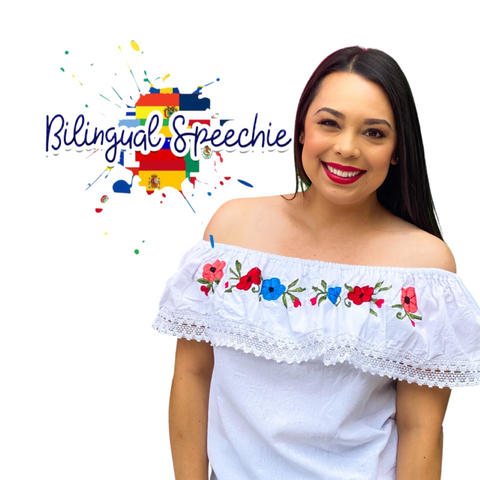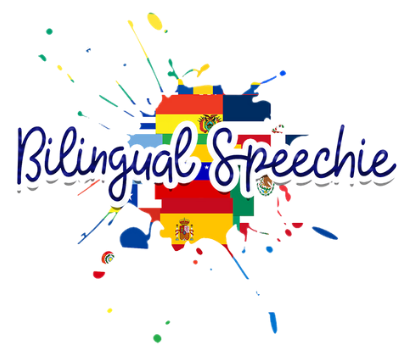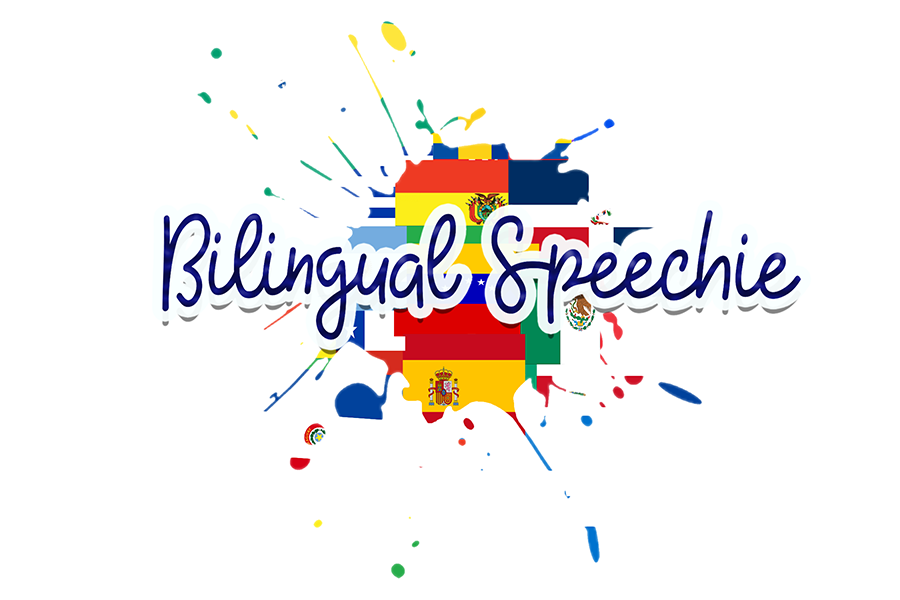by Liliana Diaz February 13, 2023 1 Comment
It's unfortunate to hear some of the following questions while working in the school setting, especially if you are working with English language learners:
However, the reality is, these comments/questions pop-up too frequently and as speech language pathologists who work with culturally and linguistically students, we need to know exactly how to respond to them, advocate for our students and ensure that they are getting the supports they need. Bilingual speech language pathologist, Stephanie Rivera Cepeda provides some interesting facts and tips in case you're ever in this situation.
The Bad, The Ugly, and Non-Inclusivity
As an SLP who has worked in dual immersion (DLI) programs, I have heard many of these comments in conversation, and received numerous questions like these from educators (SPED and general education).
We know that there are tremendous benefits for students who are able to participate in bilingual programs, however there are multiple issues that school districts often do not take into account, nor are they prepared to handle when working with bilingual populations. For example, DLI program administrators often come across challenges when working with students in special education; students who have more complex needs such as learning differences, are AAC users, have language disorders, have sensory needs, are autistic, have articulation disorders, etc. In my experience, these students have been removed from DLI programs because their needs could not be met (allegedly).
These types of cases promote non-inclusiveness which is often due to a lack of education, lack of supports for DLI programs such as understaffing, etc. the list can go on and on. Often times there are also misconceptions such as thinking that a specialized program (special day classes (SDC)) would be "a better fit for the student.”
In reality there are monumental benefits for our SPED and general education students alike. DLI promotes: metalinguistic awareness, cross cultural awareness and comprehension, social use of language, as well as exploration of cultural identity and belonging. Our school districts and administrators need to do a better job providing the adequate supports so that our students can also benefit from the DLI programs while receiving the accommodations they need.
The Good
As we now have more research to support the benefits of bilingualism/multilingualism, we have seen a massive surge in dual language immersion programs (DLIs) throughout the country, and it is apparent how these programs are wonderful contributions to the communities they are in. There are now more opportunities available for our students to embrace and formally expand knowledge of their home language, or acquire a new one. DLI programs also have opportunities for extra funding by their district, the state, and through grant programs in order to increase the quality of the bilingual instruction for their students.
But what does this mean for our BIPOC, low SES and/or students in special education (SPED)? If a DLI program is structured with the intent of inclusion, there should be methods of instruction in place to facilitate purposeful and meaningful participation. Currently the method of "Integrated Co-Teaching (ICT)" within the Dual Language (DL) program, is what is most beneficial for students with learning differences (a large percentage of the students we work with in the school setting). In case you are unfamiliar with this approach, ICT is a classroom in which the general education and a special education teacher jointly provide instruction to a class that has students with and without disabilities. By providing instruction collaboratively between a general education teacher and special educator, students can receive the instruction with adequate support in place for their success.
As SLPs, we can do great work in advocacy and educating/training in a variety of ways in order to also work towards a more inclusive model. Most DLI administrators and teachers (SPED included) are unaware of the fact that there are evidence-based methods of establishing DLI programs with not only SPED inclusion, but purposeful, strategic, embedded, support for this population. Becoming familiar with the teaching methods is one way we can be involved, however, let's review some ways that we can incorporate to work towards a solution!
6 Things SLPs Can Do To Support Their DLI Students
Resources for SLPs to Share with DLI Administrators and Educators
Dr. Diane Rodriguez, an expert in curriculum and teaching ICT in DLI for SPED populations, compiled a list from Carrasquillo & Buttaro (2004) that identified eight areas that should be evaluated when selecting teachers for bilingual learners with and without disabilities (Rodriguez, 2016). You can view the list and read more about this topic by clicking on this link:
Article for Bilingual Educators: Teaching ICT in DLI for SPED Students
To learn more about Dr. Rodriguez and her areas of expertise:
Dr. Diane Rodriguez, Associate Dean of the Graduate School of Education, Fordham University
Celebrating Bilingual Special Education By: Dr. Diane Rodriguez
Special Thank You to this Month's Guest Blogger/Author:
Stephanie Rivera Cepeda is a bilingual speech-language pathologist based out of Los Angeles, California. She graduated from Portland State University with a bilingual concentration in SLP, and worked for the the public schools in Portland, Oregon for 3 years. During those three years, Stephanie worked in elementary Spanish/English Dual immersion programs, as well as their adult transition program. Through the duration of that time, she simultaneously worked at a skilled nursing facility, as well as a hospital in rural Oregon as a per diem SLP. There, she worked with many Spanish speaking outpatients and inpatients to address a variety of communication disorders, cognitive deficits, dysphasia at bedside, as well as modified barium swallow studies. Stephanie returned to California, and has worked in the public schools ever since. During the summer of 2022 Stephanie began to co-lead the Ecuador study abroad program for the Speech and Hearing Sciences graduate students at Portland State University, as well as supervise the virtual Ecuador clinical practicum, and teach asynchronous courses.
Stephanie is also the owner of Cotorro Communication Center, LLC which currently does pro bono consulting with low SES families in Los Angeles who are seeking special education services. In the future, she aspires to open a private practice specifically in the low SES community where she grew up in order to provide accessible services for bilingual/multi-cultural populations.
Get in contact with Stephanie here:
Email: scepeda@pdx.edu
Instagram: @cotorroslp
Sources:
Boyle, A., August, D., Tabaku, L., & Cole, S. (2015). Dual language education programs: current state policies and practices. Washington, D.C: US Department of Education retrieved on April 12, 2016 from https://ncela.ed.gov/files/rcd/TO20_DualLanguageRpt_508.pdf
Carrasquillo, A. & Buttaro, L., (2004). Promoting academic success through dual language programs: Easy steps for implementing and evaluating a dual language program for native English speakers and English language learners. Woodside, NY: Bastos Educational Publishing.
Cook, S. C., & McDuffie-Landrum, K. (2020). Integrating Effective Practices Into Co-Teaching: Increasing Outcomes for Students With Disabilities. Intervention in School and Clinic, 55(4), 221–229. https://doi.org/10.1177/1053451219855739
Rodriguez, D. (2016). Teaching bilingual learners with disabilities in an integrated co-teaching dual language program. Colorín Colorado. Retrieved from https://www.colorincolorado.org/article/teaching-bilingual-learners-disabilities-integrated-co-teaching-dual-language-program
Feinberg, L. (1981, March 1). Reagan Denounces Carter's Proposed Rules on Bilingual Education . The Washington Post.
Rodriguez, D. (2009). Culturally and linguistically diverse students with autism. Early Childhood, 85(9), 313-317.
Rodriguez, D., Carrasquillo, A., & Lee. S. (2014). The bilingual advantage: Promoting academic development and biliteracy through native language in the classroom. New York, NY: Teachers College Press.
The Seal of Biliteracy. (n.d.). Retrieved December 14, 2022, from https://sealofbiliteracy.org/
Stewner-Manzanares, G. (1988). The Bilingual Education Act: Twenty Years Later. The National Clearinghouse for Bilingual Education, 6.
US Department of Education (ED). (2007, November 20). Executive summary of the No Child Left Behind Act of 2001. Home. Retrieved December 14, 2022, from https://www2.ed.gov/nclb/overview/intro/execsumm.html
US Department of Education (ED). (2020, January 16). Developing ell programs: Lau V.
Nichols. Home. Retrieved December 14, 2022, from https://www2.ed.gov/about/offices/list/ocr/ell/lau.html
Valdez, V. E., Freire, J. A., & Delavan, M. G. (2016). The gentrification of Dual Language
Education. The Urban Review, 48(4), 601–627. https://doi.org/10.1007/s11256-016-0370-0
July 22, 2023
Hey! My office janitor asked me yesterday if his daughter should study another language this semester. It feels great knowing that dual language programs provide better learning opportunities for minorities too. With that being said, she should find a teacher to guide her through an effective program afterward. https://www.trlanguages.com/admissions.html
Comments will be approved before showing up.
by Liliana Diaz December 14, 2023
by Liliana Diaz July 23, 2023
Have a client on your caseload that is demonstrating difficulty producing the CH sound? Perhaps you're a parent whose child is in speech therapy working on the CH sound? The CH sound can be a tricky sound to teach because it's hard to visually see what's going on inside the mouth when saying the sound. But no worries, here are some tips to help achieve that tricky CH sound.
by Liliana Diaz January 12, 2023
Perhaps you recently got assigned to a new school or site that consists of a large bilingual and/or multilingual caseload, and perhaps you're not bilingual. Not speaking the student's language can be quite overwhelming and stressful (trust me, I've been there!). I know the feeling of not quite knowing where to start in intervention, or not knowing how to support your students. Well luckily, bilingual SLP, Ingrid Owens-Gonzalez has some important tips to share with all SLPs. Here are 3 things Monolingual SLPs can do to support bilingual populations today.

Who are we?
Bilingual Speechie LLC. is a small business dedicated to providing inclusive and engaging speech therapy resources and activities for bilingual children, parents, SLPs and educators.
Bilingual Speechie LLC promotes bilingualism and multilingualism by dispelling common myths, providing education on bilingual language development, and promoting heritage language maintenance amongst bilingual families.
About the Owner:
Liliana Diaz-Vazquez is a certified licensed bilingual speech language pathologist (SLP), currently practicing in Chicago, Illinois. She obtained her bachelor’s degree in communication disorders (2012) and her master’s degree in speech language pathology at Saint Xavier University (2014). She is a certified member of the American Speech-Language and Hearing Association (ASHA) since 2014, a member of the Illinois Speech and Hearing Association (ISHA) since 2014 and maintains licensure in the state of Illinois.
Liliana is a first-generation Mexican-American Latina, a small business owner, a full-time school-based SLP, & a bilingual parent, who takes pride in her roots, culture, & heritage language. She loves being able to share her experience as a Latina SLP, and a bilingual mom, as well as her culture & heritage language with the educator, SLP, and parent community.
Liliana Diaz-Vazquez has extensive experience working with the bilingual English and Spanish speaking population & multilingual population. She specializes in augmentative/alternative communication (AAC), bilingual language development and language delays/disorders in bilingual/multilingual children. She has also worked in the early intervention setting for several years where she gained vast experience working with interpreters and bilingual/multilingual families.
Liliana began creating digital bilingual resources and activities in 2014 out of need while working full-time in the school setting as a SLP. Liliana worked with many Spanish-speaking families and quickly realized that there were limited Spanish and bilingual speech therapy resources available for her students and their families. In addition, Liliana quickly became aware that there was a need for education about bilingualism and typical bilingual language development as many of the families she worked with had encountered misinformation about bilingualism. Liliana began developing resources and eventually started Bilingual Speechie LLC with the mission to provide education to SLPs and families about bilingualism, as well as provide inclusive and diverse materials for speech therapy in order to help bilingual families and SLPs gain access to appropriate bilingual materials for children with communication disorders.
Today Liliana currently works full-time in the Chicago public school setting as a lead bilingual SLP where she consults and collaborates with SLPs daily to help them understand how to assess and provide culturally and linguistically appropriate services for bilingual and/or multilingual students. She also runs her small business, Bilingual Speechie LLC, and is on a mission to expand and grow her business so that all SLPs, educators, and families can have access to inclusive, diverse, and bilingual resources in a variety of languages for speech therapy.
Professional Development:
Liliana has vast experience as a speaker/presenter and has presented at several conferences over the years. You can view all previous conferences and topics that Liliana has presented on here. Liliana is available to present on topics such as best practices when working with multilingual populations, bilingual speech/language assessment and treatment, goal writing with multilingual populations and much more. If you are interested in booking Liliana for a conference or event please don't hesitate to send an email at lilianadiaz@bilingualspeechie.com
 English
en
English
en
 English
en
English
en


Liliana Diaz
Author